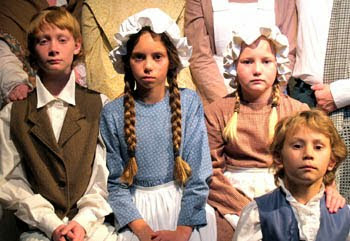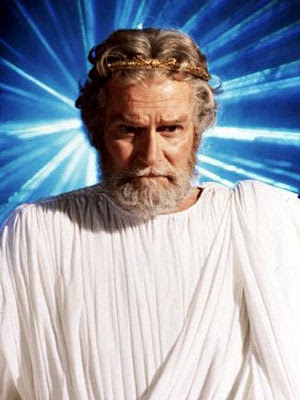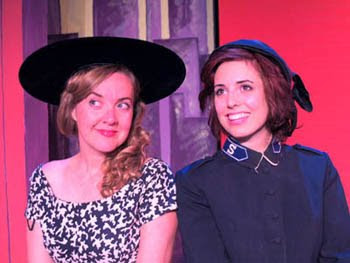Some of the actors who've played Scrooge, from top left: Jim Carrey in the current Disney film, Patrick Stewart, Michael Caine (in a Muppet version), George C. Scott, and who can forget Uncle Scrooge McDuck? But in the center is perhaps the most classic film Scrooge, Alaistar Sim in 1951. More on Dickens and this North Coast Christmas in several posts below. Click collage to enlarge.
What the Dickens is going on around here? North Coast Repertory Theatre in Eureka is currently staging a relatively faithful version of Dickens’
A Christmas Carol, and Dell’Arte is on the road with
A Commedia Christmas Carol, while Ferndale Repertory Theatre performs
Oliver!--the musical version of Dickens’
Oliver Twist.
All while a “performance capture” version of
A Christmas Carol is Disney’s big holiday movie, evidently switching their Yuletide allegiance to Dickens from Lewis Carroll (who, astute theatergoers--and readers of this blog--
may remember, inspired another Christmas coincidence of shows at Dell’Arte and Ferndale in 2007.)
Of course the Dickens story has long been a part of every Christmas season, through innumerable film and TV versions as well as adorable school pageants. Mr. Scrooge and Tiny Tim, and the Ghosts of Christmas Past, Present and Future are almost as familiar as Frosty the Snowman and Rudolph the Red-Nosed Reindeer. In an odd way, Scrooge has even become one of the Great Parts by which actors test their mettle: Ralph Richardson and Laurence Olivier played it, and more recently George C. Scott and Patrick Stewart. But the Alistair Sim 1951 film portrayal is still considered the gold standard of Scroogery. There have also been numerous animations and musical adaptations, mostly emphasizing its sentimental aspects, and therefore a few satires.
This was not the only Christmas story or scene that Dickens wrote, and some commentators suggest that his work defined many of the elements of what we now call a traditional Christmas. He even helped institutionalize the “white Christmas” expectation, despite the allegation that London gets snow at Christmas only slightly more often than Eureka.
All this may testify to the high quality of this story, while also masking it.
A Christmas Carol has the Dickens mix that made his work so popular in its time and enduring afterwards: invisible artistry, rousing entertainment, heightened characters that edge around sentimentality, social conscience, and a story of redemption.
It is perhaps the social message that should resonate strongly in this troubled year . Scrooge’s redemption is through re-balancing his attitudes: accepting joy as well as fear, and expanding the meaning of his life. As the ghost of his regretful business partner tells him,
“ Business!...The common welfare was my business; charity, mercy, forbearance and benevolence, were, all, my business. The dealings of my trade were but a drop of water in the comprehensive ocean of my business!”
Using Romulus Linney’s adaptation of
A Christmas Carol ,
North Coast Repertory Theatre sticks with the Dickens setting and story. Mercifully however, the actors do not attempt English accents. In the opening scenes of Scrooge in his dour office, one result is to suggest Melville’s 19th century Wall Street, with Scrooge in black as a Puritan capitalist. (Some commentators also suggest direct American connections to Dickens’ original tale, from how Americans celebrated Christmas to the conditions in a Pittsburgh prison Dickens visited.)

But all this is for my adult readers. The show itself is family entertainment. It is a brisk 90 minutes or so, with quick dialogue and a few effects to beguile children in the audience. But it’s the children on stage who infuse the show with vitality. The clear star of the evening is Dorian DeNisi as Tiny Tim, with other children and young actors providing the energy and feeling central to the most affecting scenes. These actors include Kelly Hughes, Alex Sutter, Meghan Walsh, Allyson Boltzen, Gaia DeNisi, Careyanna Adams, Alexandra Gellner and Isak Brayfindley.
I can’t predict the responses of children seeing it, but judging from opening night there were some laughs, and nothing that seemed too scary. Directed by Cynthia Brown, with a handsome open set by Daniel L. Lawrence, it seemed theatrically adequate holiday family fare. The featured actors speak their lines audibly, even when their backs are to the audience, and they present the story clearly. Dmitry Tokarsky is an imposing Scrooge who keeps the story moving ahead, but despite some tepid special effects, there is little actual drama in this production, and so not much joy in Scrooge’s second chance.
Among those featured actors is Brian Walker as Bob Cratchit, Evan Needham as Scrooge’s nephew, Bob Service as Marley’s Ghost, Wanda Stamp as Mrs. Crachit, and Savannah McCauley, Deborah Salizzoni and Jennifer Trustem as the other ghosts. Ben Rowe, David Moore and Pam Service round out the cast, which does a lot of doubling that’s sometimes confusing. Katie Pratt designed the lighting, Marcia Hutson the costumes, Cindy Brown the sound.
What did Christmas mean to Charles Dickens? Singing, dancing, feasting, games, good works and, for some reason, ghosts. He wrote at least ten ghost stories involving Christmastime, the most famous being
A Christmas Carol. Given commedia’s attraction to the grotesque, these Christmas ghosts would seem a natural focus for this year’s holiday show from Dell’Arte,
A Commedia Christmas Carol. And so they are.
Directed by Michael Fields, the Dell’Arte players mostly stick to the Dickens story, incorporating actual speeches from the original. But it wouldn’t be Dell’Arte if they didn’t provide comedic and satirical twists.
Scrooge (played by an energetic Gabriel McKinney) is almost a classic commedia character (the miser) but there’s a daring difference to Tiny Tim (played by Adriana Chavez): he’s no longer a 19th century malnourished and crippled child but afflicted with the 21st century American childhood scourges of obesity and asthma.
Scrooge’s nephew (Brian Kuwabara) and niece (Nicholette Routhier) are sweet and spoiled Yuppies. The contemporary fetish for competitive Christmas displays is mocked, as one man promises to let homeless people sleep in his barn if they paticipate in his Nativity scene, dressed as sheep.
But it’s the creative characterizations of the ghosts that enliven the classic laughs. Christmas Past (Emily Windler) is a literal-minded dimwit, and Christmas Present (Elizabeth Colon Nelson) is a sexy Latina. Christmas Future (Erin Crites) doesn’t speak in the Dickens story, so naturally she’s a mime in classic Marcel Marceau costume, although with extra equipment she points out.
There seemed less music than usual, but a nice balance of physical and verbal humor. For me, this was the funniest of the Dell’Arte Christmas shows I’ve seen.
Since the surprise of comedy often depends on established expectations, the familiarity of this story works to its advantage. Though the jokes and tricks were often even older than this tale (even the comically obvious game of charades must have been an ancient bit when the Marx Brothers did something like it), the novelty of seeing them employed by these characters and in the context of this story made them as fresh as they needed to be. The jokes may be repeated beyond the taste of some, perhaps because children love repetition.
As for true-to-Dickens, a couple of caveats: The best film versions of
A Christmas Carol excel at Scrooge’s complete transformation in the end—it’s meant to be as radical as a permanent religious experience, a complete liberation of inner joy and love. The Dell’Arte version is more ironic—they make comedic hay from his reversions to type and struggle to change. That’s probably more realistic and certainly funnier, but it blunts Dickens main move.
But then, Scrooge's transformation is so subversive (ironically because it is so “Christian”) it is often ignored, mostly by being smothered in sentimentality. But in essence it’s a kind of Buddhist enlightenment, a total conversion to compassion and “loving kindness.”
Neither local production really did justice to one of the scarier scenes, when Christmas Present reveals two children: “This boy is Ignorance. This girl is Want. Beware them both...but most of all beware this boy, for on his brow I see that written which is Doom, unless the writing be erased...” Those children should be truly deformed and horrifying. Though that’s hard to pull off in a family Christmas show.
The multiple-character cast members at Dell’Arte are uniformly funny (not yet named are Julie Douglas and Genesee Spridco), and several designed the terrific masks, along with Heidi Rider. Tim Gray did the music and the very effective sound cues, Jerry Lee Wallace the scenic design, Michael Foster the lighting, Lydia Foreman the costumes.
But what about those ghosts? I'm told that telling ghost stories at Christmas is an English tradition, which presumably predates Dickens. Still, much of how we celebrate the Christmas season--and much of how Dickens felt Christmas should be celebrated--is derived from very ancient festivals of the winter solstice.
In some Native American traditions, the shortest day of the year signals the promise of spring, as days grow longer and the light returns. Winter is considered a pregnancy. Also in Native traditions, as probably in many others, winter is the time for storytelling. People must be inside more, gathered around the fire, so more inclined to listen to stories.
Spirits are often characters in those stories. Some of the most spiritually and culturally important stories can be told only in the winter.
Even in Dickens time, people told stories around the fire in winter, and apparently like other fireside traditions, these included ghost stories. In
A Christmas Carol , Dickens brilliantly uses spirits to convey a spiritual message, based on the contemplation of death. The contrast of death and life is especially heightened in the context of the ideals of Christmas: charity and the joys of life.
Scrooge was a rich man who learned nobility and empathy for the poor. Oliver Twist, the hero of just the second novel in Dickens’ long career, was himself a poor boy with a noble heart, with the choice of being worked to death or preying on the rich to survive, before fate and kind-hearted people intervene.
The 1960s hit musical
Oliver! simplifies the story, and despite the extremes of mid-19th century London, capitalizes on colorful characters and the picturesque. Since it emphasizes the heartwarming morality tale as well as colorful Dickensian characters, and especially because it presents children on stage, this family-friendly musical now at Ferndale Repertory Theatre fits into this Dickens of a Christmas season on the North Coast.
Oliver!, with music, lyrics and book by Lionel Bart, is directed by Tom Phillips, with musical direction by Laura Welch, vocal direction by David Powell and Nanette Voss, and choreography by Linda Maxwell. Scenic design is by Elizabeth Uhazy, lighting by Nick Trotter, sound by Dylan Savage and Ian Shatz.
Sammy Humphrey and Jacob Smith alternate as Oliver. The large cast includes Jim Buschman, Sarah Seidt, Denim Ohmit, Janet Waddell, Dave Powell, Lynn Kermin and Dave Fuller. Oliver! plays weekends (including Sunday matinees) at Ferndale Rep until Dec. 20. Beti Trauth reviews it
here.






































